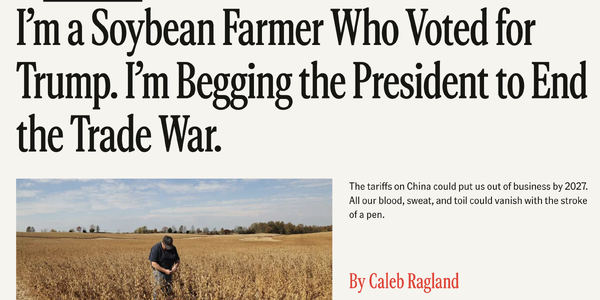ChileG
Inconceivable Member
- Messages
- 2,925
Yeah, your error was believing anything coming out of this administration
Follow along with the video below to see how to install our site as a web app on your home screen.
Note: This feature may not be available in some browsers.
If only families with high IQs are getting vaccinated, then one of the consequences will be a smarter population.
If nothing else, Trumpism has provided a fascinating (and disturbing) insight into the mindset of people who honestly seem to believe that, despite being a member of a minority hated and targeted by conservatives (blacks, Latinos, immigrants, LGBTQ, poor people, etc.) or who are married to one, that they will somehow be immune from the consequences of putting such bigots and racists into power. There have been several stories since January of white guys who are big Trumpers yet were married to immigrant women and who are now honestly shocked - shocked I tell you! - that their wife has been arrested, detained, and even deported by ICE and Trump 2.0. But at least they don't have to worry about men playing women's sports or transgenders going into girl's restrooms I guess.Yeah, your error was believing anything coming out of this administration
Right. My edit was supposed to say that low IQ people will die (Because they aren't getting vaccinated).If only families with high IQs are getting vaccinated, then one of the consequences will be a smarter population.
Confirmation bias.Right. My edit was supposed to say that low IQ people will die (Because they aren't getting vaccinated).
My initial understanding was that the people who aren't getting vaccinated will survive.

What’s next, Elian Gonzalez?Pakistani grooming gangs in UK: 'Call them rape gangs', JK Rowling joins Elon Musk's call for accountability over Rotherham scandal
In the past 24 hours, social media platform X has become the battleground for a heated debate on the alleged grooming gangs scandal in the UK. Public figures including Elon Musk, JK Rowling, and former Prime Minister Liz Truss have joined a growing chorus of voices demanding accountability over the UK's handling of child sexual abuse cases, particularly focusing on the Rotherham scandal that occurred between 1997 and 2013.
Over a period spanning years, the Yorkshire town of Rotherham experienced one of Britain's most severe child exploitation cases. An independent inquiry found that no fewer than 1,400 minors were victimized through systematic abuse. The majority of victims were young girls who were targeted, manipulated, and trafficked by organized groups of men, most of whom were of Pakistani background.

Pakistani grooming gangs in UK: 'Call them rape gangs', JK Rowling joins Elon Musk's call for accountability over Rotherham scandal | World News - The Times of India
US News: In the past 24 hours, social media platform X has become the battleground for a heated debate on the alleged grooming gangs scandal in the UK.timesofindia.indiatimes.com
This is UK Maga's "Epstein scandal"/QAnon in that it is was mostly resolved and investigated years ago but the ultra right-wingers continue to push conspiracy theories about powerful people being involved and covering up some supposedly even more massive scope.Pakistani grooming gangs in UK: 'Call them rape gangs', JK Rowling joins Elon Musk's call for accountability over Rotherham scandal
In the past 24 hours, social media platform X has become the battleground for a heated debate on the alleged grooming gangs scandal in the UK. Public figures including Elon Musk, JK Rowling, and former Prime Minister Liz Truss have joined a growing chorus of voices demanding accountability over the UK's handling of child sexual abuse cases, particularly focusing on the Rotherham scandal that occurred between 1997 and 2013.
Over a period spanning years, the Yorkshire town of Rotherham experienced one of Britain's most severe child exploitation cases. An independent inquiry found that no fewer than 1,400 minors were victimized through systematic abuse. The majority of victims were young girls who were targeted, manipulated, and trafficked by organized groups of men, most of whom were of Pakistani background.

Pakistani grooming gangs in UK: 'Call them rape gangs', JK Rowling joins Elon Musk's call for accountability over Rotherham scandal | World News - The Times of India
US News: In the past 24 hours, social media platform X has become the battleground for a heated debate on the alleged grooming gangs scandal in the UK.timesofindia.indiatimes.com



it's not just soybeans... but now Trump is threatening 100% tariffs on China and India ?
Farmer says 'we're in a very dire situation' ahead of harvest—with zero soybean orders from China, historically the largest buyer | Fortune
Caleb Ragland says his pleas to the Trump administration have fallen on deaf ears.fortune.com
This you?

I’m a Soybean Farmer Who Voted for Trump. I’m Begging the President to End the Trade War.
The tariffs on China could put us out of business by 2027. All our blood, sweat, and toil could vanish with the stroke of a pen.www.thefp.com


 www.rawstory.com
www.rawstory.com



Tell the farmers who are tired of hearing that a quick solution is coming that it should be here in about two weeks.https://www.politico.com/news/2025/09/15/farm-labor-shortage-pennsylvania-trump-immigration-00560820
Farmers in the rural region near the New York border say those stories are not unique.
“The whole thing is screwed up,” said John Painter, a three-time Trump voter who runs an organic dairy farm in Westfield. “We need people to do the jobs Americans are too spoiled to do.”
These are the voices Thompson and other farm-state lawmakers are hearing as they discuss potential solutions. Agriculture Secretary Brooke Rollins’ assurances that American workers and machines can help close the gap ring hollow among farmers who have become reliant on migrant labor that is increasingly hard to find in the face of Trump’s immigration crackdown.
The U.S. agricultural workforce fell by 155,000 — about 7 percent — between March and July, according to an analysis of Bureau of Labor Statistics data. That tracks with Pew Research Center data that shows total immigrant labor fell by 750,000 from January through July. The labor shortage piles onto an ongoing economic crisis for farmers exacerbated by dwindling export markets that could leave them with crop surpluses.
“People don’t understand that if we don’t get more labor, our cows don’t get milked and our crops don’t get picked,” said Tim Wood, a dairy farmer and a member of the Pennsylvania Farm Bureau board of directors.

Not sure why the farmers are worried. If they get hammered, the Pubs in Congress will just approve billions in new subsidies to bail them out, which will have the effect of transferring even more wealth from blue states to red states.
China’s Snub of U.S. Soybeans Is a Crisis for American Farmers
North Dakota farmers are scrambling to find extra storage space and bracing for land values to fall as soybeans that should be bound for China begin to pile up.www.nytimes.com
For the first time in the history of their 76-year-old operation, their biggest customer — China — had stopped buying soybeans. Their 2,300-acre soybean farm is projected to lose $400,000 in 2025. Soybeans that would normally be harvested and exported to Asia are now set to pile up in large steel bins.
Since President Trump imposed tariffs on Chinese goods in February, Beijing has retaliated by halting all purchases of American soybeans.
That decision has had devastating repercussions for farmers in North Dakota, which exported more than 70 percent of its soybeans to China before Trump unveiled the new tariffs this year. Unless China agrees to restart its purchases as part of a trade deal, farmers that depend on the Chinese market will be facing steep losses that could fuel farm bankruptcies and farm foreclosures around the United States.
China’s reluctance to purchase American soybeans and other agricultural products is expected to be a central topic as top officials from the United States and China meet for another round of economic negotiations in Spain this week.
Those talks are being anchored by Treasury Secretary Scott Bessent, whom Mr. Trump has put in charge of negotiating and securing a favorable trade deal with China. A win would undoubtedly curry favor with Mr. Trump. But in a strange twist, it could also help Mr. Bessent financially.
The Treasury Secretary owns thousands of acres of North Dakota farmland, worth up to $25 million. The properties grow soybeans and corn in a state that exports most of its agricultural products to China. The investments have earned Mr. Bessent as much as $1 million in rental income annually, according to his financial disclosure filings.
...
In Mr. Trump’s first term, Beijing drastically scaled back purchases of American agricultural products to gain leverage in trade negotiations after the president slapped tariffs on Chinese goods. The decision was politically calculated: Farmers tend to live in Republican states that voted for Mr. Trump, so harming them economically threatened a core constituency.
The United States and China ultimately reached a trade deal toward the end of Mr. Trump’s first term, which included a commitment from Beijing to purchase large amounts of American farm products. But it failed to live up to those commitments after the pandemic frayed its relations with the United States.
When Mr. Trump started his second term, his top economic officials promised to protect America’s farming industry as they embarked on tariff fights with China and other nations.
In August, Mr. Trump called publicly for China to step up its purchases of American soybeans in a direct plea to China’s top leader, Xi Jinping.
“Our great farmers produce the most robust soybeans,” Mr. Trump wrote on Truth Social, urging China to quadruple its orders.
The attention from the White House raised hopes among North Dakota farmers that a deal might be near. But no progress has been made. With soybean harvest season just weeks away, they warn that the situation is getting dire.
“I feel like we’re out of time,” said Justin Sherlock, 37, a farmer from Dazey, N.D.
Mr. Sherlock, who is also president of the North Dakota Soybean Growers Association, said that local banks were already starting to tighten their lending terms on farmers. That will make it hard for farms to purchase new equipment next year, further reducing their profitability and increasing the chances of closure.
“If we don’t get a deal in the next few weeks, I think this turns what is hopefully a one-year problem into a multiyear problem,” Mr. Sherlock said.
Mr. Sherlock said the standoff was particularly upsetting given that the United States spent 40 years building its soybean industry around China as its largest customer. “Are we going to lose a generation of farmers because of the trade war? I think that’s what we’re fast approaching.”


 www.rawstory.com
www.rawstory.com
